The Mate 20 & Mate 20 Pro Review: Kirin 980 Powering Two Contrasting Devices
by Andrei Frumusanu on November 16, 2018 8:10 AM EST- Posted in
- Smartphones
- Huawei
- Mobile
- Kirin 980
- Mate 20
- Mate 20 Pro
Kirin 980 Second Generation NPU - NNAPI Tested
We’ve tested the first generation Kirin NPU back in January in our Kirin 970 review – Back then, we were quite limited in terms of benchmarking tests we were able to run, and I mostly relied on Master Lu’s AI test. This is still around, and we’ve also used it in performance testing Apple’s new A12 neural engine. Unfortunately or the Mate 20’s, the benchmark isn’t compatible yet as it seemingly doesn’t use HiSilicon’s HiAI API on the phones, and falls back to a CPU implementation for processing.
Google had finalised the NNAPI back in Android 8.1, and how most of the time these things go, we first need an API to come out before we can see applications be able to make use of exotic new features such as dedicated neural inferencing engines.
“AI-Benchmark” is a new tool developed by Andrey Ignatov from the Computer Vision Lab at ETH Zürich in Switzerland. The new benchmark application, is as far as I’m aware, one of the first to make extensive use of Android’s new NNAPI, rather than relying on each SoC vendor’s own SDK tools and APIs. This is an important distinction to AIMark, as AI-Benchmark should be better able to accurately represent the resulting NN performance as expected from an application which uses the NNAPI.
Andrey extensive documents the workloads such as the NN models used as well as what their function is, and has also published a paper on his methods and findings.
One thing to keep in mind, is that the NNAPI isn’t just some universal translation layer that is able to magically run a neural network model on an NPU, but the API as well as the SoC vendor’s underlying driver must be able to support the exposed functions and be able to run this on the IP block. The distinction here lies between models which use features that are to date not yet supported by the NNAPI, and thus have to fall back to a CPU implementation, and models which can be hardware accelerated and operate on quantized INT8 or FP16 data. There’s also models relying on FP32 data, and here again depending on the underlying driver this can be either run on the CPU or for example on the GPU.
For the time being, I’m withholding from using the app’s scores and will simply rely on individual comparisons between each test’s inference time. Another presentational difference is that we’ll go through the test results based on the targeted model acceleration type.

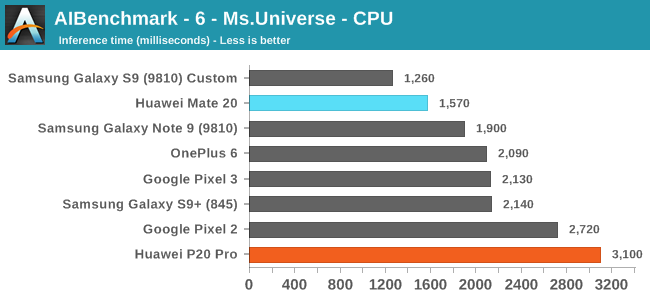
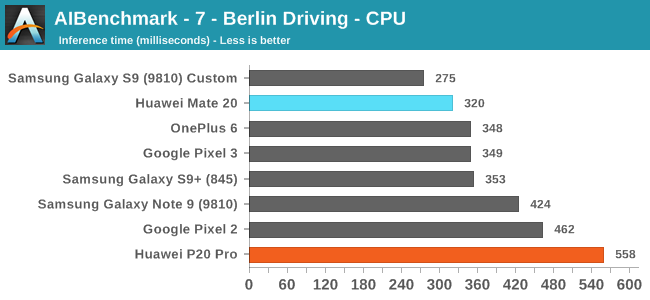
The first three CPU tests rely on models which have functions that are not yet supported by the NNAPI. Here what matters for the performance is just the CPU performance as well as the performance response time. The latter I mention, because the workload is transactional in its nature and we are just testing a single image inference. This means that mechanisms such as DVFS and scheduler responsiveness can have a huge impact on the results. This is best demonstrated by the fact that my custom kernel of the Exynos 9810 in the Galaxy S9 performs significantly better than the stock kernel of the same chip of the Note9 in the same above results.
Still, comparing the Huawei P20 Pro (most up to date software stack with Kirin 970) to the new Mate 20, we see some really impressive results of the latter. This both showcases the performance of the A76 cores, as well as possibly improvements in HiSilicon’s DVFS/scheduler.
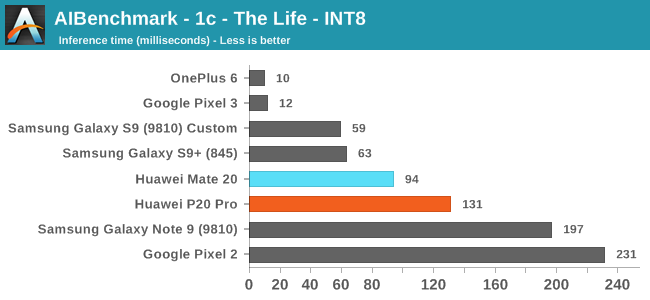
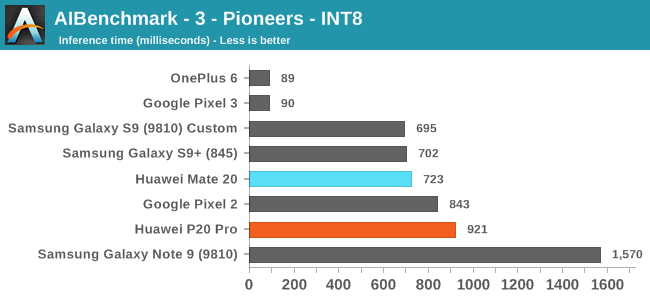
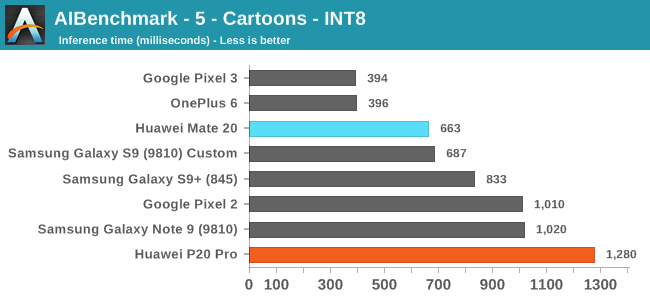
Moving onto the next set of tests, these are based on 8-bit integer quantized NN models. Unfortunately for the Huawei phones, HiSilicons NNAPI drivers still doesn’t seem to expose acceleration to the hardware. Andrey had shared with me that in communications with Huawei, is that they plan to rectify this in a future version of the driver.
Effectively, these tests also don’t use the NPU on the Kirins, and it’s again a showcase of the CPU performance.
On the Qualcomm devices, we see the OnePlus 6 and Pixel 3 far ahead in performance, even compared to the same chipset Galaxy S9+. The reason for this is that both of these phones are running a new updated NNAPI driver from Qualcomm which came along with the Android 9/P BSP update. Here acceleration if facilitated through the HVX DSPs.
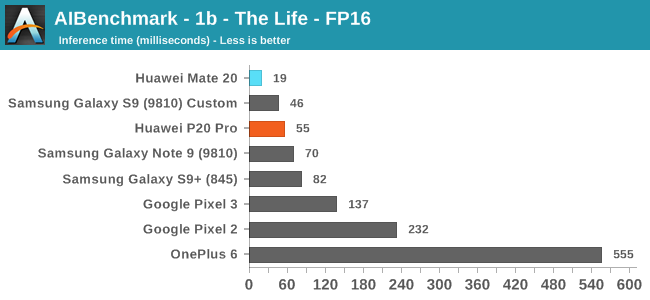
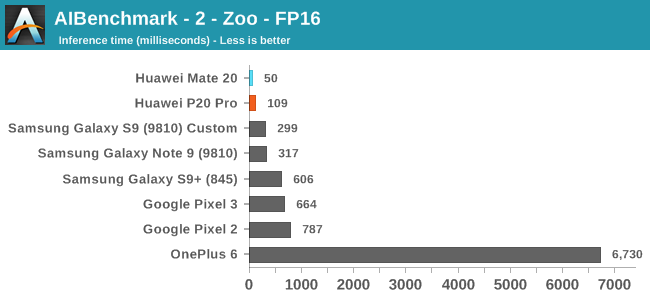
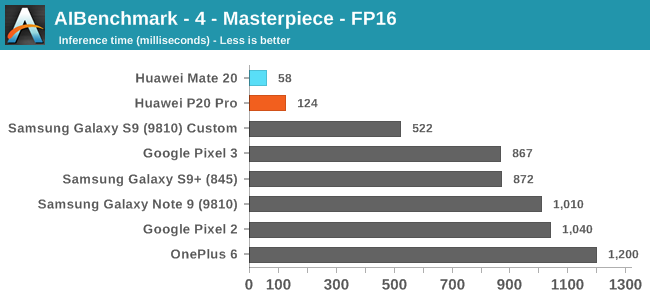
Moving on to the FP16 tests, here we finally see the Huawei devices make use of the NPU, and post some leading scores both on the old and new generation SoCs. Here the Kirin 980’s >2x NPU improvement finally materialises, with the Mate 20 showcasing a big lead.
I’m not sure if the other devices are running the workloads on the CPU or on the GPU, and the OnePlus 6 seems to suffer from some very odd regression in its NNAPI drivers that makes it perform an order of magnitude worse than other platforms.

Finally on the last FP32 model test, most phones should be running the workload on the CPU again. There’s a more limited improvement on the part of the Mate 20.
Overall, AI-Benchmark was at least able to validate some of Huawei’s NPU performance claims, even though that the real conclusion we should be drawing from these results is that most devices with NNAPI drivers are currently just inherently immature and still very limited in their functionality, which sadly enough again is a sad contrast compared where Apple’s CoreML ecosystem is at today.
I refer back to my conclusion from early in the year regarding the Kirin 970: I still don’t see the NPU as something that obviously beneficial to users, simply because we just don’t have the software applications available to make use of the hardware. I’m not sure to what extent Huawei uses the NPU for camera processing, but other than such first-party use-cases, NPUs currently still seems something mostly inconsequential to device experience










141 Comments
View All Comments
Titud - Friday, November 16, 2018 - link
It would be interesting to see a review of the BOE screen because many of the LG screens are defective and the devices with LG screens are being replaced by devices with BOE screens.Anyway, great review.
melgross - Friday, November 16, 2018 - link
While Apple and Samsung screens would be considered if they performed this way, it seems to be normal for LG’s OLEDs. Last year, the screens were pretty terrible too.With Apple investing $2.7 billion in LG for the purpose of improving g their OLED screens so that Apple can have a second OEM for them, I wonder how that’s working out. No way Apple would use these screens. But my Apple watches have been using LG screens with Apple tech. They’re fine.
kbohus - Friday, November 16, 2018 - link
Andrei,would you be so kind as to check the advertised dual-frequency Galileo GNSS capability? Easiest way is with GPSTest app by barbeauDev from Google Play.
For more info pls see https://medium.com/@sjbarbeau/dual-frequency-gnss-...
Thanks for the great review!
Andrei Frumusanu - Friday, November 16, 2018 - link
It doesn't run dual-frequency. The post you linked also includes data from a Mate 20.The L1+L5 support was in regards to the Hi1103 as far as I'm aware: https://www.anandtech.com/show/13298/hisilicon-ann...
The Mate 20's come with a BCM4359 WiFi chipset, not the Hi1103.
SydneyBlue120d - Saturday, November 17, 2018 - link
So they lied in the presentation?MyFluxi - Thursday, November 22, 2018 - link
the mate 20 pro defo has the Hi1103, see ifixit tear downpixelstuff - Friday, November 16, 2018 - link
Regarding notched displays (or lack thereof), I think the LG V35 is one of the best looking phones out there. Phone makers should strive to copy that look. Anyone that complains about the V35 bezels being too big is just being a moron.guizt - Friday, November 16, 2018 - link
Some LG panel Mate 20 Pro have serious green tint issue. Does your model affected by it?Andrei Frumusanu - Friday, November 16, 2018 - link
I'm aware of the issues, but my panel doesn't have it.colts187 - Monday, November 19, 2018 - link
Hey Andrei I know you've seen the green screen issues on the LG panels. What do you think could be the cause of it? I'm curious of your opinion since Huawei apparently doesn't want to bring it up lol.